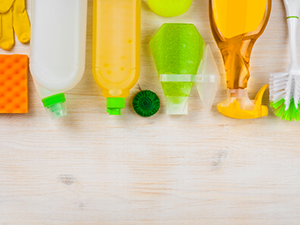
Are ‘chemical-free’ cleaning products more ‘green’ than chemicals? Should green cleaning be restricted to environmental issues, not health and safety? Bridget Gardner proposes a simple principal that cuts through this noise – cleaning without harm.
Cleaning without harm is a risk-based concept, inspired by the global movement – healthcare without harm. This movement stresses that we can’t separate environmental pollution and resource depletion from the duty of a physician to ‘first do no harm’.
Human beings require clean air and water, and healthy soil and oceans to grow the plants and animals we need to survive. Put simply, unhealthy environment = unhealthy us! It is also fitting for the cleaning industry to adopt a principal from healthcare.
After all, cleaning is integral to a facility’s health, safety and infection control strategy, whether we service a healthcare, educational, retail or commercial building.
A risk-based approach
Setting a bold aim to ‘clean without harm’ requires us to investigate where people’s health and the environment may be harmed by our work. This is powerful, because risks must first be identified and understood before can we design a targeted and effective strategy to mitigate them. Only then can we measure and quantify the benefits of green cleaning products and services.
This is completely opposite to business as usual, where a sales department ‘retrofits’ their existing product or service with a list of well-worn green buzz-words: “Can it save energy? Tick. Eco-friendly? Tick”.
Or a green cleaning program that comprises standard green methods: “Microfibre? Tick. Green chemicals? Tick”. Staff and customers are left feeling confused and clueless as to how it will benefit them or the environment.
The Australian Consumer Law prohibits businesses from engaging in any conduct that is likely to mislead or deceive consumers. So unless these environmental and health benefit statements are accurate, they could even be illegal.
Taking a risk-based approach to cleaning without harm at the design or policy stage, is highly proactive. It builds real evidence that people’s health and the environment are being protected. Identifying the concerns and risk priorities of your customers, suppliers and staff in this process, could allow you to implement efficiencies and safety initiatives far beyond your own limitations.
Sub: A holistic approach
Cleaning without harm is a principal not a rule. Your own risk analysis will determine the areas of potential harm that you need to focus your efforts on. This risk landscape will differ according to the sector, facility and environment you work in. However, you still need to take a consistent and holistic approach.
To provide such structure, Fresh Green Clean uses a holistic framework with four categories of harm-prevention to the health and wellbeing of cleaning personnel, building occupants and the wider environment:
Risk category |
Cleaning without harm framework |
| Environment | Preventing harmful and unnecessary impact on the natural environment |
| Safety | Preventing health and safety hazards to cleaners and building users |
| Infection | Preventing the transfer of pathogens (germs) from building surfaces |
| Social | Preventing exploitative and illegal employment practices |
As with an Integrated Management System, the advantage of taking a holistic approach is that it views all areas of risk in balance. It avoids creating conflicting policies, and it maximises the effectiveness of each risk mitigation strategy. Most importantly it can help us to identify the root cause of an issue.
For example, a cleaning service identified packaging waste from non-concentrated chemical products as their biggest environmental impact. But our investigation uncovered several related health, hygiene and social risks:
Risk category |
Risks and impacts |
| Environmental risks | Wasted materials due to the lack of dispensing controls and over-use while cleaning |
| Health risks | Exposure by cleaning staff via chemical handling and by building users via surface residues |
| Infection risk | Unhygienic levels of bacteria breeding in the build-up of detergent and soil germ on the frequently-touched surfaces, and poor cloth handling practices transferring germs |
| Social risks | Cleaners working extra unpaid time due poor training and inefficient systems (chemical over-use was an attempt to work faster) |
There are now multiple strategies for addressing these risks, including: concentrated chemicals, dosing controls, training and systems, packaging re-use, or chemical-free technology.
By taking a holistic approach, we can assess each option against the risks we have identified and find a balanced solution. Furthermore, staff and clients will be confident that each strategy is meeting a real need, with real and measurable benefits.
I hope that the principal of ‘cleaning without harm’ is adopted by the cleaning industry because it pulls our focus back to the core role of a service – to care.
*Bridget Gardner is principal director of Fresh Green Clean. She can be contacted on bridget@freshgreenclean.com.au or au.linkedin.com/pub/bridget-gardner/15/597/9a5/
This first appeared in the September/October issue of INCLEAN Australia magazine.